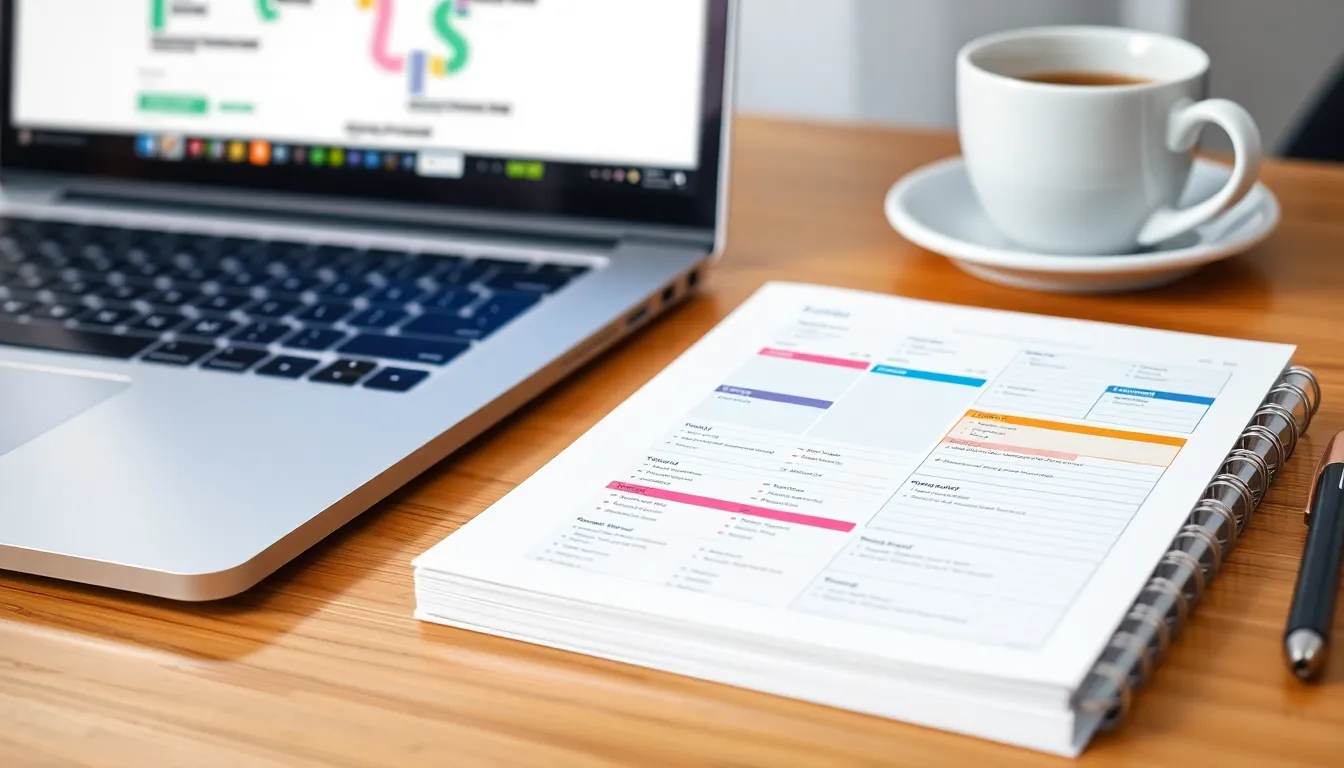Table of Contents
ToggleIn a world where to-do lists seem to multiply faster than rabbits, digital planners have emerged as the superhero of organization. Gone are the days of scribbling reminders on sticky notes that mysteriously vanish. With a few taps on a screen, anyone can transform chaos into clarity, making procrastination a thing of the past—or at least, more manageable.
Overview of Digital Planners
Digital planners gained popularity for their efficiency in managing tasks. Users benefit from features like customizable templates and reminder settings. These planners often integrate with calendars, enhancing users’ organization capabilities.
Functionality extends beyond simple task lists. Users can incorporate goal setting, note-taking, and project tracking into their daily routines. Many digital planners support cloud-based storage, ensuring accessibility across multiple devices.
Platforms like Notion, Todoist, and Trello exemplify popular digital planners. Each tool offers unique functionalities tailored to varying user needs. For instance, Notion combines note-taking and task management, while Trello focuses on visual organization through boards.
Adopting a digital planner can streamline daily activities. Users manage priorities effectively, decreasing feelings of overwhelm associated with traditional lists. Ratings often highlight user-friendly interfaces that facilitate quick navigation and task updates.
Digital planners appeal to students, professionals, and families alike. Each group benefits from the flexibility and structure these tools provide. By embracing digital planning, they gain clarity and control over their schedules, enhancing productivity in all aspects of life.
Benefits of Using Digital Planners

Digital planners provide several advantages, significantly enhancing how users manage their time and tasks.
Improved Organization
Digital planners facilitate better organization by centralizing tasks, deadlines, and notes in one accessible location. Users can customize layouts to fit their preferences, ensuring that everything has a designated space. Tags and categories within these planners promote efficient sorting and retrieval of information. Integrating calendars allows users to sync events and appointments, preventing scheduling conflicts. Color-coding tasks adds another layer of visual clarity, making it easier to distinguish between different priorities. Overall, a digital planner simplifies daily organization, promoting a structured approach to tackling responsibilities.
Increased Productivity
Increased productivity is a notable advantage of utilizing digital planners. Features like reminders and notifications encourage timely task completion, reducing procrastination. Users can break down large projects into manageable steps, allowing for consistent progress tracking. Digital planners often incorporate goal-setting tools, aligning daily tasks with long-term objectives. Cross-device synchronization ensures information remains up to date, making it accessible at any time. Through these functionalities, digital planners transform how users approach their workloads, fostering a proactive work ethic and driving greater efficiency.
Popular Digital Planner Apps
Digital planner apps simplify the task management process. Several tools offer unique features that cater to specific user needs.
Features to Consider
Customization options enhance usability. Users should look for templates suited to their personal or professional requirements. Integration with calendars prevents scheduling conflicts effectively. Reminders and notifications promote timely completion of tasks. Collaboration features prove vital for team projects. Choosing a planner that allows tagging and categories streamlines task organization. Synchronization across devices ensures access to important information anytime, maximizing productivity.
User Experience and Interface
Intuitive design principles enhance navigation within apps. A clean layout improves overall user interaction. Color-coded tasks provide quick visual references for prioritization. Touch-friendly controls accommodate both mobile and desktop environments. Features like drag-and-drop functionality facilitate easy task management. Feedback options allow users to share experiences or propose improvements. A positive user experience leads to effective engagement with digital planners, making daily management and organization seamless.
Comparing Digital Planners to Traditional Planners
Digital planners and traditional planners serve similar purposes, yet they differ significantly in functionality and user experience. Users often find that digital planners offer superior flexibility, allowing for seamless updates and modifications. Traditional planners, on the other hand, rely on physical space and structure, which can limit adaptability.
With digital planners, customization plays a key role. Individuals create layouts that suit their specific needs, using templates or designing from scratch. Traditional planners provide predetermined formats, which may hinder personalization. Many digital platforms also facilitate collaboration, making it easier for teams to work together, while traditional planners require manual sharing of information.
Accessibility stands out as another advantage of digital planners. They sync across devices, ensuring users can access their plans anytime, anywhere. Traditional planners lack this versatility, relying solely on the physical document. Cloud-based storage for digital planners enhances organization, enabling users to store notes and files alongside their tasks.
Efficiency gains further support the argument for digital planners. Features like reminders and notifications prompt users to complete tasks punctually, while traditional planners rely on self-discipline alone. The ability to break down complex projects into smaller tasks becomes easier through digital tools, leading to consistent progress.
In terms of visual appeal, digital planners frequently utilize color-coding and tagging to enhance task management. Traditional planners do not typically afford the same visual clarity, as they depend on standard ink and paper. Customization options, combined with intuitive designs, create an engaging experience in digital planning that traditional methods struggle to replicate.
Tips for Maximizing the Use of Digital Planners
Customize configurations to streamline your workflow by adjusting templates and layouts to fit personal preferences. Integrate calendar syncing for real-time updates and avoid conflicts with scheduled events. Leverage color-coding to categorize tasks, enhancing visual organization across various projects and responsibilities.
Utilize reminders and notifications to stay on track with deadlines, ensuring timely completion of tasks. Break down larger projects into smaller, manageable steps that facilitate a steady workflow. Collaborate efficiently within apps that support team features, allowing for shared access and real-time updates on group projects.
Experiment with different digital planner apps to discover which platform meets specific needs. Consider tools like Notion for comprehensive project management or Trello for straightforward task organization. Evaluate user interfaces to find ones that offer intuitive navigation and touch-friendly controls.
Review notes regularly to maintain focus on priorities and adapt strategies as necessary. Seek feedback from peers on planner effectiveness, which can reveal new features or methods to optimize usage. Consolidate all planning efforts in one accessible tool, reducing time spent switching between different applications.
Test various planning methods within the digital planner to identify what best enhances productivity. Explore the wealth of customization options available, enabling tailored experiences that directly align with individual goals. Adjust settings to maximize accessibility, ensuring planners are available across devices for seamless transitions throughout the day.
Digital planners are revolutionizing the way individuals manage their tasks and projects. With their customizable features and seamless integration, they provide an efficient alternative to traditional planning methods. Users can enjoy enhanced organization and productivity through intuitive designs that adapt to their unique needs.
The ability to access planners across devices ensures that important information is always at hand. As more people discover the benefits of digital planners, they’ll likely continue to transform daily routines and workflows. Embracing these tools can lead to a more structured and proactive approach to managing tasks, ultimately fostering success in both personal and professional endeavors.







